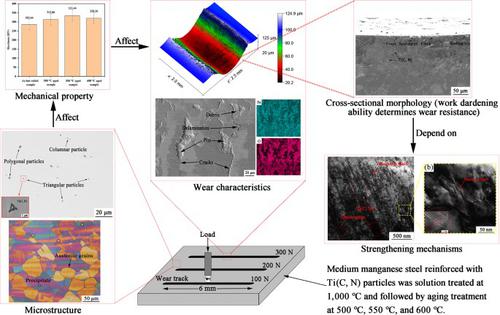Friction ( IF 6.8 ) Pub Date : 2023-03-25 , DOI: 10.1007/s40544-022-0712-8 Zhihui Cai , Shangkun Wang , Yanjun Zhou , Jiayi Dong , Lifeng Ma , Shilong Liu

|
In this study, the hot rolled medium manganese steel containing titanium was solution treated at 1,000 °C and followed by aging treatment at 500, 550, and 600 °C. The influence of aging treatment on mechanical properties and wear resistance of medium manganese steel reinforced with Ti(C,N) particles was investigated. It was found that the matrix of medium manganese steel was austenite. The austenite grain size was refined, and Ti(C,N) particles were precipitated after aging treatment. Compared to that of the as-hot rolled sample, the initial hardness of 500 °C aged sample increased by 9.5% to 312.86 HV, whose impact energy was more than doubled to 148.5 J. As the aging temperature raised to 600 °C, the initial hardness changed slightly. However, the impact energy dropped significantly to 8 J due to the aggregation of Mn at the grain boundaries. In addition, the main wear mechanisms of the samples were fatigue wear and abrasive wear. It was worth noting that 500 °C aged sample exhibited the best wear resistance under a 300 N applied load, whose wear loss was just half of the as-hot rolled sample. The relationship between wear loss and mechanical properties indicated that the wear resistance of medium manganese steel was independent of the initial hardness. The large difference in the wear resistance was predominately due to the outstanding work hardening ability of 500 °C aged sample, whose strengthening mechanisms were contributed from transformation induced plasticity (TRIP) effect, dislocation strengthening, twinning induced plasticity (TWIP) effect, and precipitation strengthening.
中文翻译:

时效处理对Ti(C,N)颗粒增强中锰钢力学性能和耐磨性的影响
在这项研究中,含钛热轧中锰钢在1000℃下进行固溶处理,然后在500℃、550℃和600℃下进行时效处理。研究了时效处理对Ti(C,N)颗粒增强中锰钢力学性能和耐磨性的影响。结果发现,中锰钢的基体为奥氏体。时效处理后奥氏体晶粒细化,并析出Ti(C,N)颗粒。与热轧态样品相比,500℃时效样品的初始硬度提高了9.5%,达到312.86HV,冲击功提高了一倍多,达到148.5J。随着时效温度升高到600℃,初始硬度略有变化。然而,由于Mn在晶界处的聚集,冲击能显着下降至8J。此外,样品的主要磨损机制为疲劳磨损和磨粒磨损。值得注意的是,500℃时效样品在300N外加载荷下表现出最好的耐磨性,其磨损量仅为热轧样品的一半。磨损量与力学性能之间的关系表明,中锰钢的耐磨性与初始硬度无关。耐磨性的巨大差异主要是由于500℃时效样品出色的加工硬化能力,其强化机制来自相变诱导塑性(TRIP)效应、位错强化、孪晶诱导塑性(TWIP)效应和析出强化。值得注意的是,500℃时效样品在300N外加载荷下表现出最好的耐磨性,其磨损量仅为热轧样品的一半。磨损量与力学性能之间的关系表明,中锰钢的耐磨性与初始硬度无关。耐磨性的巨大差异主要是由于500℃时效样品出色的加工硬化能力,其强化机制来自相变诱导塑性(TRIP)效应、位错强化、孪晶诱导塑性(TWIP)效应和析出强化。值得注意的是,500℃时效样品在300N外加载荷下表现出最好的耐磨性,其磨损量仅为热轧样品的一半。磨损量与力学性能之间的关系表明,中锰钢的耐磨性与初始硬度无关。耐磨性的巨大差异主要是由于500℃时效样品出色的加工硬化能力,其强化机制来自相变诱导塑性(TRIP)效应、位错强化、孪晶诱导塑性(TWIP)效应和析出强化。磨损量与力学性能之间的关系表明,中锰钢的耐磨性与初始硬度无关。耐磨性的巨大差异主要是由于500℃时效样品出色的加工硬化能力,其强化机制来自相变诱导塑性(TRIP)效应、位错强化、孪晶诱导塑性(TWIP)效应和析出强化。磨损量与力学性能之间的关系表明,中锰钢的耐磨性与初始硬度无关。耐磨性的巨大差异主要是由于500℃时效样品出色的加工硬化能力,其强化机制来自相变诱导塑性(TRIP)效应、位错强化、孪晶诱导塑性(TWIP)效应和析出强化。



























 京公网安备 11010802027423号
京公网安备 11010802027423号